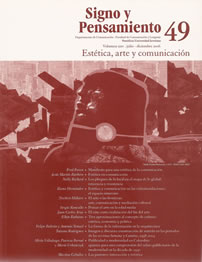Abstract
The transits and transformations of art, as from the second half of the 20th Century, have generated a new dynamic for the relationships between tradition and modernity, globalization and fragmentation of the public, standardization and aesthetic innovation, rationalization and experimentation, cultural forms and industrial formats; at the same time, they have also highlighted the cultural value of technological transformations. This article considers the death and reincarnation of art. In this new art, exchanges speed up thus producing the ‘in-materialization’ of space and the compression of time, leading also to the banality of aesthetics, the convergence of rationality and narrative, the impoverishment of the aesthetic experience. Art is nowadays embedded in the culture but the boundaries of common culture have been blurred and the meaning of art itself is being questioned. However, as an opening to the issue, it is shown that the reading keys of the new friction points are closely related to the original art-communicationdesign scheme.This journal is registered under a Creative Commons Attribution 4.0 International Public License. Thus, this work may be reproduced, distributed, and publicly shared in digital format, as long as the names of the authors and Pontificia Universidad Javeriana are acknowledged. Others are allowed to quote, adapt, transform, auto-archive, republish, and create based on this material, for any purpose (even commercial ones), provided the authorship is duly acknowledged, a link to the original work is provided, and it is specified if changes have been made. Pontificia Universidad Javeriana does not hold the rights of published works and the authors are solely responsible for the contents of their works; they keep the moral, intellectual, privacy, and publicity rights.
Approving the intervention of the work (review, copy-editing, translation, layout) and the following outreach, are granted through an use license and not through an assignment of rights. This means the journal and Pontificia Universidad Javeriana cannot be held responsible for any ethical malpractice by the authors. As a consequence of the protection granted by the use license, the journal is not required to publish recantations or modify information already published, unless the errata stems from the editorial management process. Publishing contents in this journal does not generate royalties for contributors.


